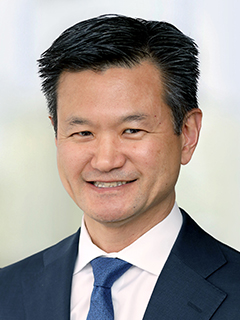A tale of two economies
Lower rates will benefit parts of the economy.

November 4, 2025
The Federal Reserve’s Senior Loan Officer Opinion Survey (SLOOS) revealed banks tightened their lending standards for businesses of all sizes during the third quarter. Lending standards for consumers did not change much.
For commercial and industrial (C&I) loans to businesses, 7% of banks tightened their lending standards to large and middle market firms (e.g., businesses with annual revenue of $50 million or more), down modestly from the 10% reading in the second quarter. For C&I loans to small businesses (annual sales of under $50 million), 8% of banks tightened standards, the same percentage as in the second quarter.
On the demand side, business loan demand from small firms was close to neutral, neither strong nor weak. For large and middle market firms, 12% of banks reported strong demand for the most recent quarter, a material improvement from the 30% reporting weak demand in the second quarter.
For all commercial real estate (CRE) loans, 4% of banks tightened their lending standards in the third quarter, down from 9% previously. On residential real estate lending, banks’ lending standards were little changed. However, there was a notable improvement on the demand side for mortgage loans with 9% of banks reporting stronger demand versus 12% reporting weaker demand in the prior quarter. Chalk it up to lower mortgage rates as the 30-year fixed rate is currently around 6.20%, down from near 7% at the start of 2025. Refinancing activity has been stronger than applications for purchase, as those who were last into the housing market are looking to lower their mortgage ratee. Housing affordability is still a hurdle and goes well beyond mortgage rates, encompassing everything from the sharp jump in prices to insurance and real estate taxes post pandemic.
The October SLOOS included a set of special questions which asked about the likelihood of approving C&I and credit card loan applications since the start of the year. Banks cited firms’ investment needs to build inventories which contributed to the strength in demand. We saw a surge in inventory building ahead of expected shifts in tariffs. The first occurred in March, and another round hit in July to get ahead of potential changes tariffs in August. More tariff investigations are underway. The full effects of tariffs are not expected to be felt until well into 2026. The peak effective tariff rate is now close to 15%, nearly 10% below the implied level associated with the April 2 announcements and nearly a year after the fact. Inventories are expensive to carry and expected to be drained in the fourth quarter.
On the household side, for credit card loans, banks were more likely to approve credit card applications for super-prime and prime borrowers while less likely to approve those for subprime borrowers. We are increasingly seeing signs of a k-shaped economy and rising inequality. Those that live paycheck to paycheck are feeling shut out. Delinquencies on subprime vehicle loans have hit their highest level since 2010. The losses for credit cards have receded a bit, as credit card issuers tightened credit conditions as the 2021 vintage of credit cards hit a speed bump in delinquencies once COVID-era stimulus evaporated.
Banks cited firms’ investment needs to build inventories which contributed to the strength in demand.

Ken Kim
KPMG Senior Economist
Bottom Line
The latest SLOOS depicts a bifurcated economy. Banks reported stronger loan demand for large firms while smaller firms reported stagnation. For households, prime borrowers continued to enjoy access to capital while subprime borrowers have fewer choices. That is while overall credit conditions for publicly traded companies eased in recent months, with credit spreads narrowing across the board. Those who have money are getting more access to debt, while those who do not are feeling locked out.
We are still betting on a December rate cut by the Fed but it is not a foregone conclusion. Lower rates will benefit parts of the economy but not all boats will be lifted equally. Monetary policy and rate cuts are blunt tools and do not address inequality. Indeed, lower rates tend to accrue more to the owners of capital as they buoy asset prices but cannot increase debt burdens for those who are already deeply indebted, paying much higher rates. The cuts represent a smaller percentage of their loan costs than those who have lower rates to start with.
Explore more

Uncertain economic outlook sways bankers
Lending standards are becoming tighter.

KPMG Economics
A source for unbiased economic intelligence to help improve strategic decision-making.

Policy in Motion: Insights for navigating with confidence
Your resource for the latest on trade, tariff and regulatory policy changes.
Meet our team

Subscribe to insights from KPMG Economics
KPMG Economics distributes a wide selection of insight and analysis to help businesses make informed decisions.